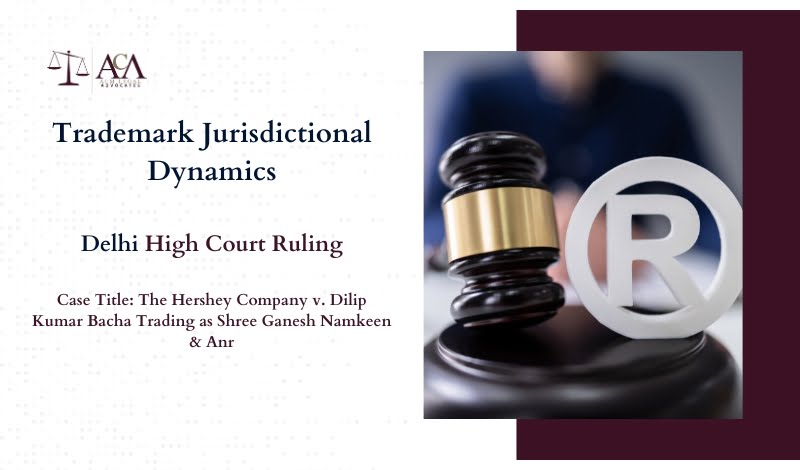The legal conundrum regarding the jurisdictional reach of the High Courts in handling rectification/cancellation petitions under the Trade Marks Act, 1999 saw significant developments in 2024, specifically marked by judicial deliberations in the Delhi High Court.
The case that brought these issues to the forefront was The Hershey Company v. Dilip Kumar Bacha Trading as Shree Ganesh Namkeen & Anr (C.O. (COMM.IPD-TM) 179/2023 & connected matters)[1]. The bench, comprising Acting Chief Justice Manmohan and Justices Vibhu Bakhru, Sanjeev Narula, Tara Vitasta Ganju, and Manmeet Pritam Singh Arora, delved into the nuanced query: whether rectification or cancellation petitions under the Trade Marks Act of 1999 should be confined to High Courts within whose jurisdiction the Trade Mark Registry offices, which granted the registrations, are situated, or could they also extend to High Courts experiencing the dynamic effects of such registrations?
The proceedings were instigated by a judgement passed by Justice Prathiba M. Singh on February 9, 2024, which questioned the prevailing interpretations and called for a larger bench’s consideration due to the discrepancy with Justice C. Hari Shankar’s conclusions in Dr. Reddy’s Laboratories Ltd v. Fast Cure Pharma.
Legal Framework and Judicial Inquiry
The core of the judicial examination revolved around interpreting sections of the Trade Marks Act, 1999, specifically in the wake of amendments brought by the Tribunal Reforms Act, 2021. The main questions referred to the larger bench for adjudication included:
- Applicability of the decision in Girdhari Lal Gupta v. K Gian Chand Jain rendered under the Designs Act, 1911, in the context of the Trade Marks Act, 1999, post-amendment by the Tribunal Reforms Act, 2021, for determining the jurisdiction of a High Court under Section 57 of the Trade Marks Act.
- The basis of jurisdiction of the High Court under Section 57 of the Trade Marks Act, 1999: whether it should be on account of the ‘appropriate office’ of the Trade Mark Registry which granted the impugned trade mark registration.
- The interpretation of ‘the High Court’ within the meaning of Sections 47, 57, and 91 of the Trade Marks Act, 1999, and whether it could be construed differently across these sections.
The High Court’s quest for answers entailed delving into the legislative intent, the statutory framework and the principles governing judicial jurisdiction, especially in matters relating to intellectual property.
The legal deliberations were enriched by the inclusion of Senior Advocate Gaurav Pachnanda as amicus curiae, tasked with assisting the court in navigating through the complex legal questions presented. The bench also navigated through conflicting judicial precedents, notably the divergent interpretations by Justices Prathiba M. Singh and C. Hari Shankar, thereby underscoring the need for a definitive judicial stance on the jurisdictional aspects under the Trade Marks Act.
Arguments and Deliberations
The petitioners, led by The Hershey Company, argued against the restrictive interpretation that confined the filing of rectification petitions to High Courts within whose jurisdiction the respective Trade Mark Registry offices were situated. They contended for a broader interpretation, allowing for the filing in any High Court where the adverse effects of the trademark registration were experienced, thereby reflecting the nationwide impact of such registrations.
On the other hand, the respondents, including Dilip Kumar Bacha Trading as Shree Ganesh Namkeen, supported a narrower interpretation, aligning with the traditional approach that tethered the jurisdiction strictly to the geographical confines of the Trade Mark Registry offices that issued the registrations.
Judicial Analysis and Interpretation
The Delhi High Court scrutinized the relevance of the Designs Act, 1911 decision in Girdhari Lal Gupta v. K Gian Chand Jain and its applicability to the context of the Trade Marks Act, 1999, particularly in light of the amendments introduced by the Tribunal Reforms Act, 2021.
A significant part of the court’s deliberation focused on interpreting the term ‘the High Court’ as used in Sections 47, 57 and 91 of the Trade Marks Act, 1999. The bench pondered over whether this term should be understood as referring to any High Court within the country or should be specifically linked to the High Court within whose jurisdiction the office of the Trade Mark Registry that issued the registration is located.
The court also weighed the arguments regarding the jurisdiction being influenced by the ‘dynamic effect’ of the trademark registration, a concept suggesting that the reach of a trademark’s impact could extend beyond the geographical limitations of the registry office, potentially implicating multiple jurisdictions.
Acting Chief Justice Manmohan and the accompanying justices delved into the legislative intent behind the Trade Marks Act, examining whether the law aimed to centralize jurisdiction with a select few High Courts or intended to allow broader access to justice for aggrieved parties across India.
Verdict and Implications
In reaching its verdict, the Delhi High Court meticulously balanced the competing interests of trademark owners, the broader public, and the imperatives of judicial efficiency and access to justice. The court’s decision, while rooted in the specifics of the Trade Marks Act, 1999, and the Tribunal Reforms Act, 2021, also reflected a nuanced understanding of the complexities inherent in trademark law and its national implications.
While the court reaffirmed the importance of adhering to legislative intent and statutory mandates, it also acknowledged the challenges posed by the modern commercial environment, characterized by the widespread impact of trademarks across territorial boundaries. The bench’s judgement aimed to streamline the process for rectification/cancellation petitions while ensuring that the rights of trademark owners and the interests of the public were adequately protected.
Conclusion: Reflecting on the Path Forward
The Delhi High Court’s examination and decision in the case of The Hershey Company vs. Dilip Kumar Bacha Trading as Shree Ganesh Namkeen & Anr mark a significant milestone in the Indian trademark jurisprudence. The ruling not only clarifies the jurisdictional conundrums faced by trademark practitioners but also aligns the legal framework with the realities of modern commerce, where trademarks transcend local boundaries to impact nationwide markets.
This judgement reinforces the principles of legal certainty and access to justice, ensuring that aggrieved parties have clear guidelines on where to file rectification or cancellation petitions. It underscores the importance of the judicial process in adapting to changes in legislative frameworks, such as those introduced by the Tribunal Reforms Act, 2021, while respecting the legislative intent and the statutory scheme of the Trade Marks Act, 1999.
For businesses, legal practitioners, and the judiciary, the verdict serves as a pivotal reference point, guiding the handling of trademark disputes and enhancing the predictability and efficiency of legal proceedings in the domain of intellectual property rights. As the dust settles on this landmark judgment, the focus now shifts to its implementation and the potential ripple effects on trademark litigation strategies and jurisprudence in India.






